
East Grinstead High Level Station: Gallery 2
1920s - late 1950s 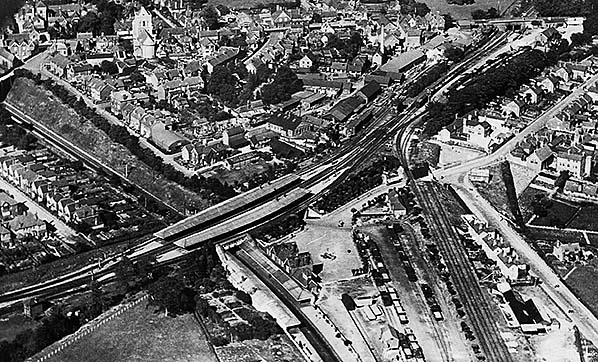
This view, believed to date from the 1920s, provides a good insight of East Grinstead's railways as they were at the time including the High and Low Level stations. At bottom centre is the line to Culver Junction, part of which is a now the heritage Bluebell Railway while at bottom left is the line towards Three Bridges and the start of St Margaret's Curve which connected the High Level station to the Oxted line. Also at bottom left can be seen East Grinstead West signal box, this controlled sections to Rowfant and St Margaret's Junction. The Low Level goods yard is visible towards lower right and there was of course a connection, out of view here, with the Culver Junction (Lewes) line. Interestingly the bridge over Railway Approach has been reduced to a single track span; the other two sidings, centre and right of the three, had once extended a few yards further north to terminate on the bridge. At top right are the sites of the original terminus and second stations plus London Road bridge, just ahead of which had stood the building for the second station. The original station house, while difficult to discern, stands camera side of the goods shed. Today it is the only surviving building associated with the original station. Click here for a larger version.
Photo from John Mann collection 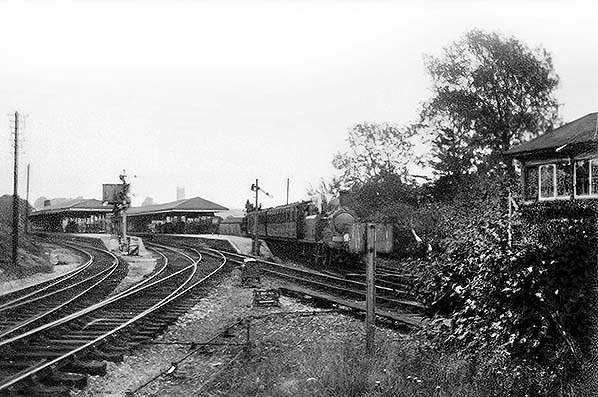
An undated view looking due east across High Level with what appears to be a Stroudley Class E1 departing with a train for Three Bridges. The scene is very difficult to date with any accuracy but is perhaps c.1930. Close scrutiny shows the locomotive carries a single word on its tank and this could only be "Southern", so the period is certainly post 1923. The E1 Class began life in 1874 as the E Class and was intended primarily for goods and shunting work, although use on branch passenger services, such as here, was not uncommon. Four of the class ended up on the Isle of Wight. The final examples at work for British Railways bowed out in 1961 but one example had been sold to a colliery in 1927 and continued to work until 1963. It has survived to be the sole example in preservation.
Photo from John Mann collection 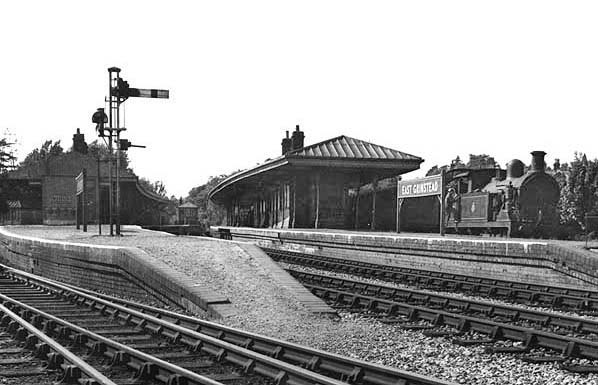
An unidentified H Class 0-4-4T stands at Platform 6. Close examination reveals she wears the early BR device, often lampooned as 'The Cycling Lion', which was replaced from 1956 as and when locomotives visited the paint shops. She is coupled to a 'Birdcage' coaching stock set. Both observations suggest this photograph dates from fairly early in the BR period. The train being at Platform 6 implies the train is an Oxted - Tunbridge Wells West service. There were a limited number of such services during the peak hours and they ran semi fast, for example omitting Lingfield, Dormans, Hartfield and Withyham.
Photo from John Mann collection 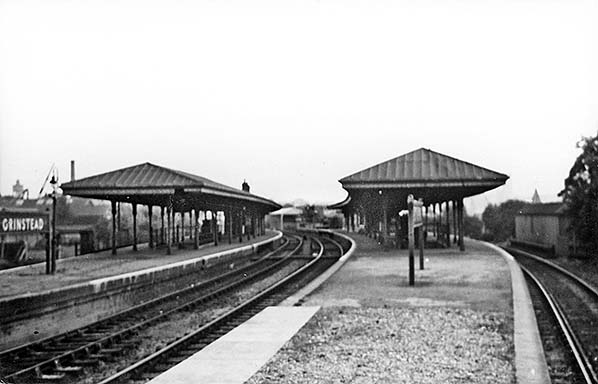 East Grinstead station looking east from platforms 3/4 in October 1953
Photo from John Mann collection 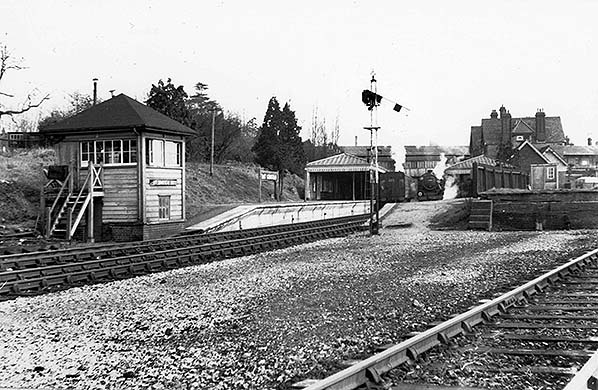
The Low Level platforms facing north in March 1954. At centre right is the station building with the High Level platforms in the background. At extreme right background part of the High Level Platform 3 can be seen; this spot gave a good view over the Low Level goods yard, station forecourt and the line towards Kingscote over Imberhorne Viaduct. In the right foreground is the connecting spur between Low and High Level goods yards. The dock on the right was served by the siding at right foreground and at one time a further siding served the end of the dock, running through the open space in the centre of the picture. The connecting line between Low and High Level goods yards is out of view to the right. East Grinstead South signal box stands on the left. On 15 September 1958 it became East Grinstead C 'box, and was given a green enamel nameboard stating simply 'East Grinstead' but with a small plate bearing simply 'C' mounted beneath it. The 'box was abolished in 1987 as part of the re-signalling associated with electrification of the line, by which time it bore a corporate black and white nameboard. Electrification, incidentally, arrived some forty-five years late. The Southern Railway had planned large scale electrification which included the line to East Grinstead Low Level and thence to Haywards Heath via Ardingly. The Depression and then the Second World War ensured the only section of this route to receive the third rail was Copyhold Junction (Haywards Heath) to Horsted Keynes. With electrification to East Grinstead in 1987 the section south as far as Imberhorne Viaduct was also electrified as it was used as a siding and this was the only part of the 'Bluebell' line to ever see the third rail (Ardingly branch electric trains used a platform at Horsted Keynes which was not part of the 'main' line to Culver Junction). In this scene one of the LMS designed but Brighton built Fairburn tanks is signalled away from the Down platform. It has come from Oxted and will proceed to Culver Junction and Lewes, possibly beyond. The 'Bluebell' line was to close in 1955 and the story of what happened subsequently needs no explanation here. In the Up platform is 3-set No. 633. Known by some as 'Trio Sets', these were 'Birdcage' sets with a 'Birdcage' brake at each end. For some reason a few of these sets had the guard's 'Birdcage' lookout removed from one end and No. 633 was among them. The 'de-birdcaged' vehicle is that nearest the camera, it being Brake Third No. S3470S. This vehicle was withdrawn in October 1956 but the other two, Composite Lavatory S5499S and Brake Third Lavatory S3543S, were converted for Push-Pull operation by which time S3543S had also lost its 'Birdcage'. The conversion occurred during 1957, quite late for these becoming-rather-ancient ex-SE&CR vehicles. Among the pictures of the High Level platforms are a few showing trains comprising some of these conversions to 2-car Push-Pull sets. They were ultimately replaced by conversions of ex main line Maunsell sets, these in turn being ultimately largely replaced by Diesel Electric Multiple-Units. If the photographer of this 1954 scene were able to stand on the same spot today, he would be more or less standing at the northern end of the heritage Bluebell Railway's platform.
Photo
by RM Casserley
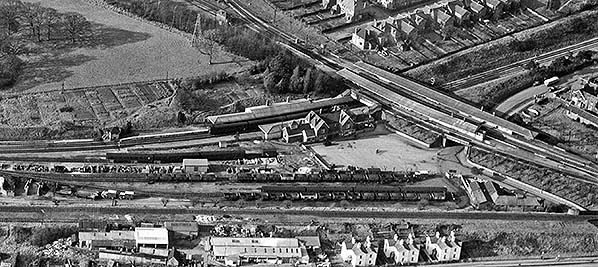
One of two views over the station complex taken in 1954, this one facing north-west. The station itself needs no description except to note the canopy length of the Low Level Up platform compared to that of the Down platform. The Up platform would have been the busier of the two at the Low Level. Such provision at High Level was more generous and until closure it was by far the busier part of the station. Low Level was something of a quiet backwater until 1967, even before the line to Horsted Keynes and Culver Junction closed. This is the line seen sneaking away at left centre. The Low Level signal box can also be seen left of centre. This was South Box and in accordance with the renaming of the High Level boxes to 'A' and 'B' on 15 September 1958 it became 'C' Box. With the closure of High Level it reverted to 'East Grinstead'. South Box dated from 1 August 1882 and had a Saxby & Farmer 15-lever frame. It survived until 18 July 1987. As a point of interest, there was also a North Box which dated from 1883 and had a Saxby & Farmer 12-lever frame. It was abolished by the Southern Railway on 9 October 1928. Further towards the bottom of the picture is the Low Level goods yard which appears to be predominantly occupied by coal wagons although there are two rakes of coaching stock present. Also visible is the connection to the High Level goods yard, with one of the tracks, which previously crossed the bridge, bottom right, now truncated. At top left of centre behind the pylon, the belt of trees marks the course of the original line from Three Bridges as it approached East Grinstead's original terminus and second station. The general area of the Low Level yard is now, 2023, largely occupied by Sainsbury's and its car park. The modern East Grinstead station building is a little further south from the original seen here and the heritage Bluebell Railway's platform is located at extreme left. Click here fore a larger version.
Photo from Britain From Above, reproduced with permission 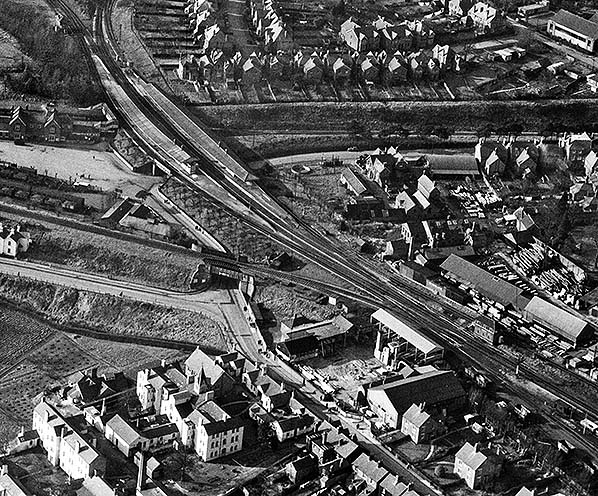
One of two views over the station complex taken in 1954, this one facing west north west. By the 1950s there were plenty of motor vehicles on the roads yet in both 1954 aerial views very few can be seen; this and the lay of shadows suggests the photographs were taken on a evening. Some pedestrians can be seen but in those days, while some people went out to, say, a cinema during an evening especially on Saturdays, most people went home at the end of the working day and remained at home until the following morning. Crossing Station Approach bridge is the connection link between the Low and High Level yards. To the right of the bridge are stacks of sleepers and it would appear track lifting is ongoing, which would leave just a single track crossing the bridge. In due course the bridge itself would be reduced to single track span. Photographs of the East signal box are not common, although it can be seen in the background of some photographs taken from the High Level platforms. This view does at least show its front elevation which makes clear it was the largest of all the 'boxes at East Grinstead. With its 43-lever Saxby & Farmer frame, it remained in use until the line closed. To the north of the signal box is a timber yard which was served by a siding visible here running behind the 'box. Facing the 'box. i.e. on the south side of the railway is another timber yard. Both were still in operation at the time the railway closed but no longer exist. The clutter of buildings at bottom left was the East Grinstead Union Workhouse, dating from 1859. The 'T' shaped building in the centre of the complex was the main block while the building to its south was a hospital of sorts for people with infectious diseases. The complex also had a chapel and a school. The site of the workhouse at East Grinstead is acknowledged by a path named 'Institute Walk' which serves a modern housing development and various commercial premises. Click here fore a larger version.
Photo from Britain From Above, reproduced with permission 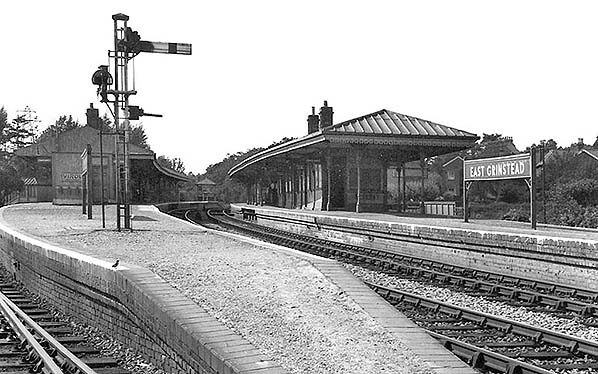 East Grinstead station looking west during the 1950s. Platforms are from left to right 3, 4, 5 and 6. Beyond the platforms St Margaret's Curve and the Oxted line is to the right with the Three Bridges line straight ahead. East Grinstead West signal box is seen in the distance.
Photo from John Mann collection 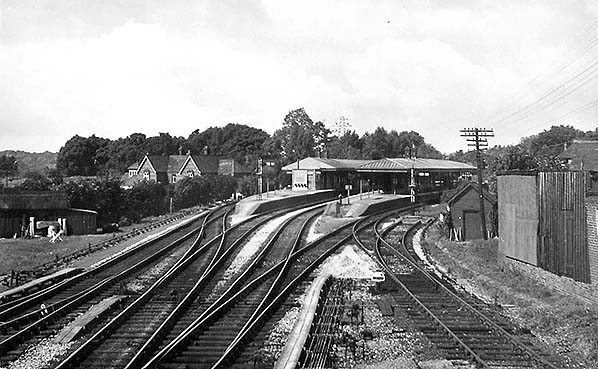
Looking east from the West signal box towards the high level platforms c1950s. Platforms are from left to right 3/4 and 5/6. The entrance building is seen to the left.
Photo from John Mann collection 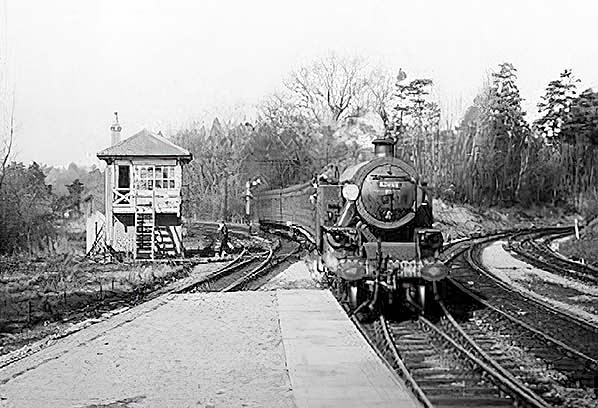 Sometime in the 1950s a Fairburn 2-6-4T arrives with a train from Three Bridges. Its number is unfortunately illegible, otherwise it would have been possible to narrow down the year. British Railways had built a batch of these LMS-designed locomotives for use on the Southern Region but all were transferred away during the 1950s in exchange for BR Standard 2-6-4Ts, with the last Fairburn leaving the Southern Region in 1959. The train is passing East Grinstead West signal box. This had a Saxby & Farmer 27-lever frame (East 'box had a 43-lever frame of the same origin). It will be noticed there is just a Home signal in the background, not the bracket signal visible in later views. On 15 September 1958 West 'box, which sat on the pre 1883 track alignment, was renamed 'A Box' and East was renamed 'B Box'. It is not unreasonable to assume changes to signalling occurred at the same time.
Photo from John Mann collection 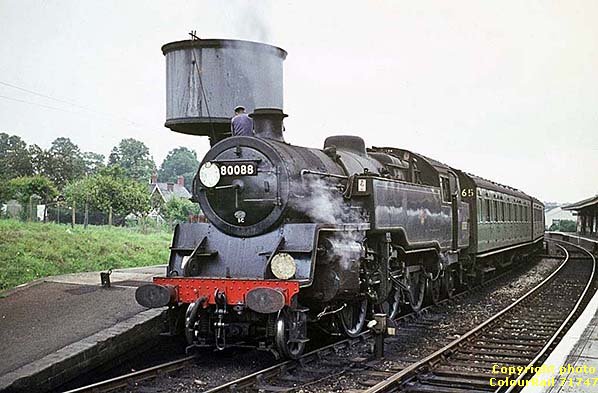
In March 19567 a BR Standard 4MT 2-6-4T No. 80088 takes on water at Platform 5. Upon departure this train will proceed to St Margaret's Junction and thence onto the Oxted line. The 'SC' on the smokebox door refers to 'Self Cleaning' which in simple terms meant ash in the smokebox was pulverised and then ejected from the chimney. New ex-Brighton Works in July 1954, she went new to the London Midland Region and would have had four lamp/disc brackets with the additional two for Southern requirements being fitted when transferred south. Class members intended for the Southern Region at the outset left works complete with six brackets. No. 80088 was withdrawn in June 1965 and did not survive into preservation.
Copyright photo from ColourRail
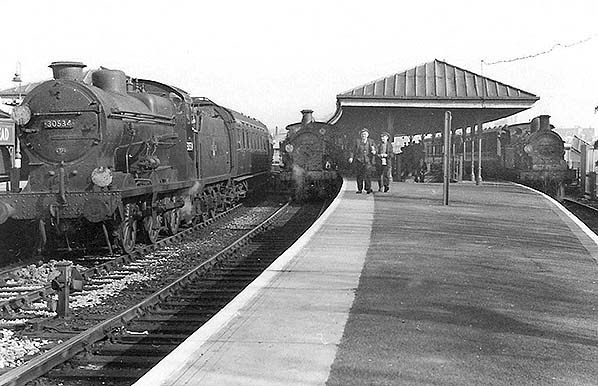
An ostensibly busy scene photographed sometime between 1956 and 1962, 'ostensibly' because human activity appears to be mainly, if not entirely, in the form of staff. Maunsell Q Class No. 30534 on the left carries the 1956 BR device on her tender. Withdrawn from Brighton shed in December 1962, at the time of this photograph she was allocated to Norwood Junction. She is presumably working a Tunbridge Wells West - Victoria service. Also present are two H Class locomotives on local Push-Pull workings; left, Three Bridges - Tunbridge Wells West and right, same but in the opposite direction.
Photo
from John Mann collection
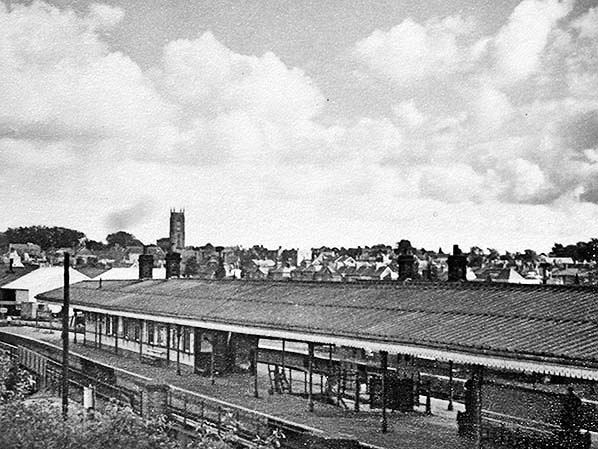 Facing south-east from Grosvenor Road on an unknown date late50s/early 1960s. The church, left background, is St. Swithun's. Facing south-east from Grosvenor Road on an unknown date late50s/early 1960s. The church, left background, is St. Swithun's.Photo by Alan & Lynne Cullen Click here for East Grinstead High Level: Gallery 3
1959 - 1962
 Home
Page Home
Page
|

